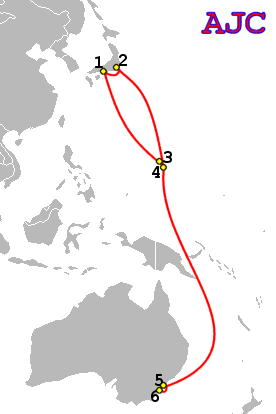Australia–Japan Cable
| Australia–Japan Cable (AJC) | |
|---|---|
 | |
|
Owners: Telstra, BT, Verizon Business, Softbank | |
| |
| Total length | 12,700 km |
| Topology | collapsed loop design |
| Design capacity |
640 gbit/s (2001) 1000 gbit/s (2008) >4000 gbit/s (2013)[1] |
| Currently lit capacity |
80 gbit/s (2001) 240 gbit/s (2008) 320 gbit/s (2013)[1] |
| Technology | Fibre-optic |
| Date of first use | 2001 |
The Australia–Japan Cable, or AJC, is a 12,700 km submarine telecommunications cable system linking Australia and Japan via Guam[2] that became operational in 2001. It had an original design capacity of 640 Gbit/s, but was initially equipped to utilise only 80 Gbit/s of this capacity. In April 2008 a capacity upgrade was completed, bringing equipped capacity to 240 Gbit/s. Design capacity was also increased to 1000 Gbit/s. Further upgrades will increase equipped capacity to meet increasing demand.[3]
The AJC network employs a collapsed loop design that features diverse landings in Australia, Guam and Japan and diverse routing at water depths less than 4000m. This design reduces cost by utilising a common sheath in deep water, where risk of failure is low, but provides redundancy to mitigate risk in shallower waters and in the landing stations.
The network supports a range of access interfaces, including SDH at STM1, STM4, STM16 and STM64 levels, 2.5G clear, Direct Wavelength Access, Gigabit Ethernet and 10 Gigabit Ethernet. A range of protection options are available, including SDH span and ring protection and 1:n wavelength redundancy.
The cable has a design life to 2026.
Landing points
- Shima, Japan
- Maruyama, Chiba, Japan
- Tanguisson, Guam, unincorporated territory of the United States
- Tumon Bay, Guam, unincorporated territory of the United States
- Oxford Falls, Sydney, Australia
- Paddington, Sydney, Australia
Ownership
AJC is jointly owned by Telstra, BT, Verizon Business and Softbank.[2]
See also
- Other Australian international submarine cables (and year of first service):
- Pipe Pacific Cable (2009)
- Telstra Endeavour (2008)
- Southern Cross Cable (2000)
- SEA-ME-WE 3 (2000, Australian portion in service earlier)
- JASURAUS (1997)
- Pacrim West (1995)
References
- 1 2 http://www.ajcable.com/
- 1 2 Australia-Japan Cable completes refinancing Archived October 11, 2009, at the Wayback Machine.
- ↑ Australasian Region, International Cable Protection Committee.